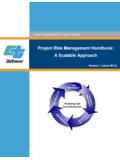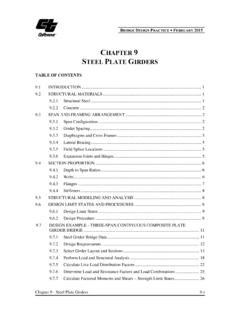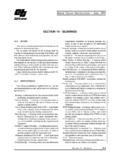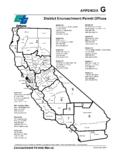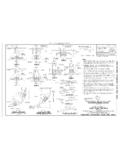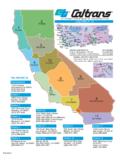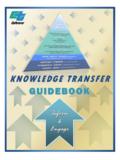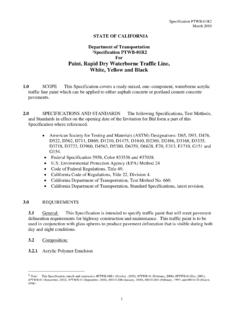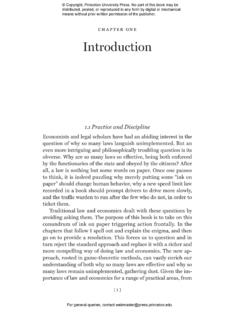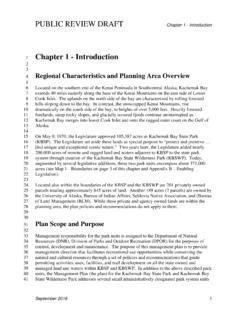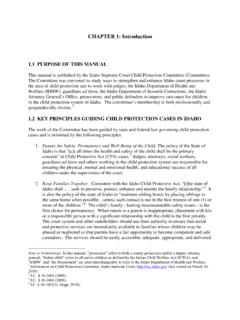Transcription of CHAPTER 1 – Introduction Table of Contents
1 CHAPTER 1 Introduction Table of Contents Project Development Procedures Manual 07/01/1999L 1-i CHAPTER 1 Introduction Table of Contents CHAPTER 1 Introduction .. 1- 3 SECTION 1 About this Manual .. 1- 3 Reference Information .. 1- 3 Purpose .. 1- 3 Defining the Project Development Process .. 1- 3 Historical Background .. 1- 3 Current Release .. 1- 4 Implements Laws and Policies .. 1- 4 Provides Guidance .. 1- 5 Special Situations .. 1- 5 Mandatory Procedural Requirements .. 1- 5 SECTION 2 Related Manuals and Guidelines .. 1- 6 Headquarters Division of Design Manuals and Guidelines Relating to Project Planning and Design .. 1- 6 Other Caltrans Manuals and Guidelines .. 1- 6 Other Manuals and Guidelines.
2 1- 10 SECTION 3 Abbreviations Used in this Manual .. 1- 11 SECTION 4 Transportation Planning Leads to Project Development .. 1- 21 ARTICLE 1 General .. 1- 21 Planning Coordination .. 1- 21 Region and System Planning .. 1- 21 Intermodal Surface Transportation Efficiency Act of 1991 .. 1- 21 ARTICLE 2 Transportation Systems .. 1- 22 Transportation Systems .. 1- 22 Roadway Systems .. 1- 22 State Highway System .. 1- 22 Subsystems .. 1- 22 Federal Systems .. 1- 23 ARTICLE 3 Regional and System Planning .. 1- 24 Continuing, Comprehensive, Cooperative Planning .. 1- 24 State System Planning .. 1- 24 Management Systems .. 1- 29 Master Plans .. 1- 32 Priority Lists .. 1- 32 State Highway Inventory .. 1- 33 Regional Transportation Planning.
3 1- 33 Part 1 General Information 1-ii 07/01/1999L Project Development Procedures Manual Air Quality Conformity .. 1- 34 Planning Concept .. 1- 34 Planning Scope .. 1- 34 Major Investment Studies .. 1- 35 District Input to Regional Transportation Plans .. 1- 35 Regional Transportation Plan Purpose .. 1- 35 Memorandum of Understanding Integrating the National Environmental Policy Act and Section 404 Processes .. 1- 37 Local Transportation Planning .. 1- 38 Goods Movement .. 1- 38 Other Plans .. 1- 38 ARTICLE 4 Corridor Planning .. 1- 38 Corridor Policy .. 1- 38 Corridor Preservation .. 1- 39 Corridor Preservation Process .. 1- 39 SECTION 5 Project Development Philosophy .. 1- 41 Balanced Transportation Projects.
4 1- 41 Various Perspectives Considered .. 1- 41 Implementation .. 1- 41 Table of Figures FIGURE 1-1 Metropolitan Planning Organizations .. 1- 26 FIGURE 1-2 Regional Transportation Planning Agencies .. 1- 27 CHAPTER 1 Introduction Section 1 About this Manual Project Development Procedures Manual 07/01/1999L 1-3 CHAPTER 1 Introduction SECTION 1 About this Manual Reference Information Some of the references found in this CHAPTER have hyperlinks that connect to Caltrans intranet pages which are not displayable to the general public. Until such time that the specific reference becomes available on the internet, the user will have to contact their district liaison, Caltrans project manager, or the appropriate Headquarters division to inquire about the availability of the reference.
5 Purpose The Headquarters Division of Design (DOD) has the responsibility for the development and consistent application of Caltrans policies for the project development process. It maintains this manual, the Project Development Procedures Manual (PDPM), to provide guidance for project development on State Highway System projects. Emphasis of the PDPM is directed toward State highway projects; however, projects on local transportation systems and other modes are also discussed. Defining the Project Development Process For the purposes of this manual, the project development process is defined as spanning those activities and that time frame that commence with project initiation and end with the assembly of the Final Project Records after project construction.
6 Historical Background The original PDPM (Gold Book) was written to provide instructions for implementing the State highway project development process outlined in the California Action Plan for Transportation Planning and Development, published in June, 1973. The Action Plan was developed in compliance with Federal requirements stated in Title 23 United States Code, Section 109(h), and with its implementing memorandum issued by the Federal Highway Administration (FHWA). The purpose of this Action Part 1 General Information 1-4 07/01/1999L Project Development Procedures Manual Plan was to provide a process to assure the consideration of economic, social, and environmental effects of transportation projects in parallel with engineering and technical aspects.
7 It provided guidelines and procedures for implementing two related pieces of legislation: the National Environmental Policy Act of 1969 (NEPA) and the California Environment Quality Act of 1970 (CEQA). The Action Plan is no longer in effect as an official document, but its basic requirements are still in force and are included in the PDPM. Current Release This seventh edition of the PDPM represents a reformatting of the sixth edition of the Gold Book, with changes to bring it up-to-date with the current organization of Caltrans and other revisions to make it current. It conforms to the layout of the sixth edition, which represented an entire rewrite of the Gold Book that brought it up to date with current policies and legislation.
8 It reflects the July 1988 (and subsequent) delegations of authority for project development to the District Directors. It focuses on the integral role of Caltrans project development philosophy as it relates to the project development process. This new release is intended to supersede all previous editions and changes to the PDPM. It is intended to complement the Project Development Workflow Tasks Manual, which describes typical project development tasks that occur during the project development process. Implements Laws and Policies The PDPM reiterates many State and federal laws and policies that affect the development of transportation projects in California; however, it is federal laws (statutes and regulations), Executive Orders, Department of Transportation and FHWA and other federal regulations, California law (statutes and regulations), as well as Caltrans Director s Policy Memoranda and Deputy Directives that establish the legal requirements and policies used by Caltrans to carry out project development functions.
9 The PDPM is not intended to establish legal standard for these functions, nor does it impose legal requirements different from, or in addition to, those imposed by law. In many cases, specific statutes have been quoted; however, there has been no attempt to include a complete listing of all applicable laws or regulations. CHAPTER 1 Introduction Section 1 About this Manual Project Development Procedures Manual 07/01/1999L 1-5 Provides Guidance The processes and procedures established in this manual are provided for the information and guidance of the officers and employees of Caltrans, as well as for any local entity, private developer, or consultant engaged in project development activities involving California state highways.
10 It is not intended that any standard of conduct or duty toward the public shall be created or imposed by this manual. Statements specifying duties and responsibilities of any given classification of officers or employees mentioned herein refer solely to duties or responsibilities of such classification to their management, to various members of the project development team, or to their relationships with organizational units in Caltrans. There is also no intent to impose organizational requirements on any Caltrans district beyond that which is already established by the Caltrans policy process. Special Situations Many of the processes and procedures in this manual are subject to change as circumstance and experience warrant.
